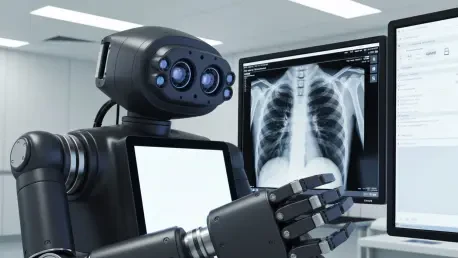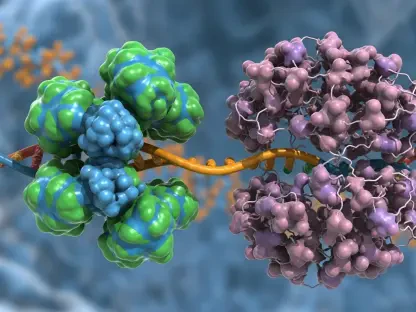In the rapidly evolving landscape of pediatric healthcare, the integration of artificial intelligence (AI) into radiology is capturing attention for its potential to transform how fractures are diagnosed in children, offering hope for more accurate and timely interventions. A landmark study recently published in Pediatric Radiology by Altmann-Schneider, Geiger, Kellenberger, and colleagues delves into this innovative territory, providing a detailed multivendor comparison of AI software designed for automated fracture detection in young patients. The challenge of accurately identifying fractures in children is significant, given their unique skeletal anatomy and the often subtle presentation of injuries on imaging. Traditional diagnostic methods, while valuable, can sometimes lead to missed or delayed diagnoses due to human variability. This research evaluates how AI, powered by sophisticated deep learning algorithms, might bridge these gaps, providing a glimpse into a future where technology enhances precision and speed in pediatric care. The findings promise to guide medical professionals in adopting tools that could redefine diagnostic workflows.
Revolutionizing Diagnosis with AI Technology
The potential of AI to revolutionize diagnostic precision in pediatric radiology stands out as a key takeaway from this comprehensive study. These advanced systems, leveraging deep learning, analyze medical imaging such as X-rays at remarkable speeds, often detecting intricate fracture patterns that might be overlooked by even seasoned professionals. For pediatric patients, where early and accurate identification of injuries is paramount to prevent long-term health issues, this capability offers a significant advantage. The research indicates that many AI tools surpass conventional methods in both speed and objectivity, thereby reducing the risk of missed diagnoses. This technological edge could mean the difference between a swift recovery and prolonged complications for children, highlighting the transformative impact AI could have in clinical settings focused on young patients.
Beyond precision, the consistency provided by AI systems marks a substantial improvement over traditional human interpretation. Variability among radiologists—stemming from factors like fatigue, stress, or differing levels of expertise—can sometimes affect diagnostic outcomes, particularly in complex pediatric cases. AI, on the other hand, delivers standardized results, unaffected by external pressures or personal conditions. This uniformity ensures that every child’s imaging receives the same meticulous analysis, minimizing the chances of error. The study emphasizes that such reliability is especially critical in pediatric fracture detection, where a single oversight can have serious repercussions for a child’s growth and well-being. This consistency fosters trust in diagnostic processes across diverse healthcare environments.
Optimizing Clinical Workflows Through Automation
AI’s ability to enhance efficiency in clinical workflows emerges as another compelling benefit highlighted by the research. By automating the routine task of fracture detection, these software systems allow radiologists to redirect their focus toward more complex cases that require nuanced human judgment. This shift can significantly reduce wait times for pediatric patients, ensuring they receive timely interventions without unnecessary delays. In busy hospitals or understaffed facilities, where resources are often stretched thin, such efficiency could prove invaluable. The study suggests that integrating AI into daily practice not only streamlines operations but also improves the overall quality of care by prioritizing critical cases, ultimately benefiting young patients who need prompt attention.
The broader implications of AI adoption extend to modernizing healthcare systems as a whole. The findings point to the potential for these technologies to optimize resource allocation, ensuring that medical staff can dedicate more time to direct patient interaction and complex diagnostics. This could lead to better patient outcomes and a reduction in the strain on healthcare professionals, particularly in pediatric departments where emotional and physical demands are high. Moreover, standardizing diagnostic accuracy across different facilities helps address disparities in care quality, a persistent challenge in many regions. The research underscores that embracing AI could set new benchmarks for pediatric treatment, paving the way for systemic improvements that prioritize both efficiency and empathy in medical practice.
Addressing Challenges in AI Integration
Despite the promising outlook, integrating AI into pediatric radiology is not without significant hurdles, as the study carefully outlines. Issues such as data privacy, software reliability, and the ethical implications of relying on automated systems for critical health decisions pose substantial concerns. Ensuring that patient information remains secure while using AI tools is paramount, as breaches could undermine trust in healthcare systems. Additionally, the reliability of these systems under varying imaging conditions or with less common fracture types remains a point of scrutiny. The research stresses the need for transparency through rigorous testing and validation to confirm that AI tools are both safe and effective for use in sensitive pediatric contexts, advocating for a cautious approach to implementation.
Equally important is the need for clinicians to fully understand the capabilities and limitations of AI technologies. The study highlights that while these tools can enhance diagnostic processes, over-reliance without human oversight could lead to errors, especially in atypical cases where AI might falter. Ethical dilemmas also arise when considering how much decision-making power should be delegated to machines, particularly in scenarios involving children’s health. Educating medical professionals about the balanced use of AI ensures that it serves as a supportive tool rather than a standalone solution. The findings call for ongoing dialogue within the healthcare community to establish guidelines that address these challenges, ensuring that the integration of AI prioritizes patient safety and trust above all.
Emerging Trends in Healthcare Technology
A prominent trend identified in the research is the perception of AI as a complementary asset rather than a replacement for radiologists. The consensus across the evaluated systems suggests that AI functions best as a decision-support mechanism, augmenting human expertise with data-driven insights. This perspective aligns with broader movements in healthcare technology, where the focus is on enhancing, not supplanting, professional skills. The study’s comparison of various AI software reveals differences in performance among vendors, yet collectively underscores significant potential to improve fracture detection in pediatric patients. This collaborative approach between technology and human judgment promises to refine diagnostic accuracy while maintaining the critical human element in medicine.
Another notable trend is the push for responsible innovation in adopting AI within medical practice. The research advocates for structured frameworks to guide this integration, balancing technological advancements with stringent patient safety and ethical standards. This reflects a growing recognition in the healthcare sector that while AI offers substantial benefits, its deployment must be carefully managed to prevent risks such as over-dependence or breaches in confidentiality. The path forward, as suggested by the findings, lies in a measured approach that involves continuous evaluation and adaptation of AI tools. By fostering an environment of cautious progress, the medical community can harness the advantages of AI while safeguarding the well-being of young patients, ensuring technology serves as a force for good.
Reflecting on the Path Ahead
Looking back, the exploration of AI software for detecting fractures in pediatric patients marked a significant milestone in healthcare technology. The study demonstrated that many of these tools achieved high levels of accuracy and consistency, often surpassing traditional diagnostic methods, while also streamlining clinical workflows. It shed light on AI’s role as a supportive partner to radiologists, enhancing their ability to deliver timely and precise care to children. Yet, it also brought attention to the ethical, technical, and practical challenges that accompany this integration, urging a balanced perspective on technology’s place in medicine.
Moving forward, the insights from this research offer a roadmap for healthcare providers and policymakers. Prioritizing ongoing evaluation and robust regulatory oversight will be crucial to refine AI systems and address their limitations. Investing in clinician training to ensure effective collaboration with AI tools can further maximize benefits. As technology evolves, fostering partnerships among medical professionals, technologists, and ethicists will help shape a future where AI and human expertise work seamlessly to improve pediatric outcomes, setting a standard for compassionate, cutting-edge care.









